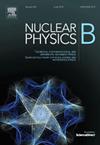Thermodynamics of Euler-Heisenberg AdS black hole surrounded by quintessence field using shadow
IF 2.5
3区 物理与天体物理
Q2 PHYSICS, PARTICLES & FIELDS
引用次数: 0
Abstract
We extend the black hole solution of Euler-Heisenberg gravitational theory in AdS space-time by introducing quintessence field in it and studied thermodynamics and phase structure using both semi classical analysis and shadow formalism by considering Λ as thermodynamic pressure. We compare the results obtained by these two methods. The N-type change in temperature for can be seen. The nature of Gibbs free energy ensures the second order phase transition for , which agrees with the temperature behaviour and then derived heat capacity, Joule-Thomson coefficient to study local stability and heating (or cooling) effect. Assuming black hole as a thermodynamic engine, we calculate the efficiency of Carnot cycle and Rankin cycle and study the impact of various black hole parameters on them. We also studied Ruppeiner thermodynamic geometry in {S,Q} thermodynamic phase space to study the BH at molecular level.
求助全文
约1分钟内获得全文
求助全文
来源期刊

Nuclear Physics B
物理-物理:粒子与场物理
CiteScore
5.50
自引率
7.10%
发文量
302
审稿时长
1 months
期刊介绍:
Nuclear Physics B focuses on the domain of high energy physics, quantum field theory, statistical systems, and mathematical physics, and includes four main sections: high energy physics - phenomenology, high energy physics - theory, high energy physics - experiment, and quantum field theory, statistical systems, and mathematical physics. The emphasis is on original research papers (Frontiers Articles or Full Length Articles), but Review Articles are also welcome.
 求助内容:
求助内容: 应助结果提醒方式:
应助结果提醒方式:


